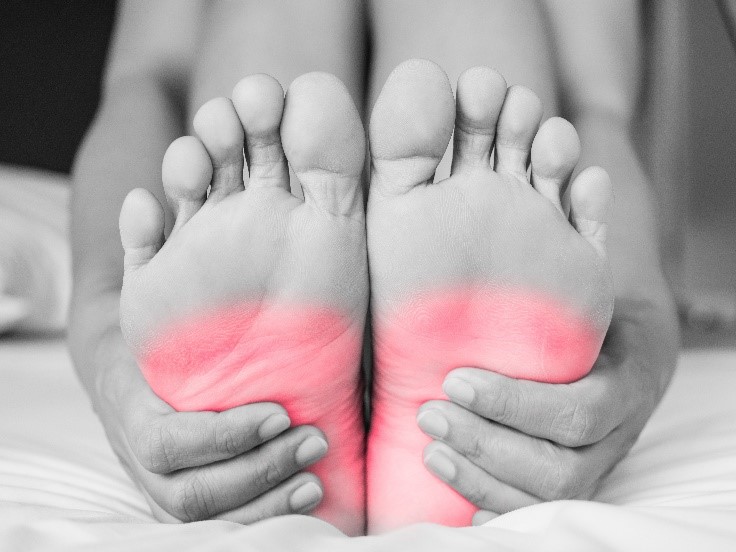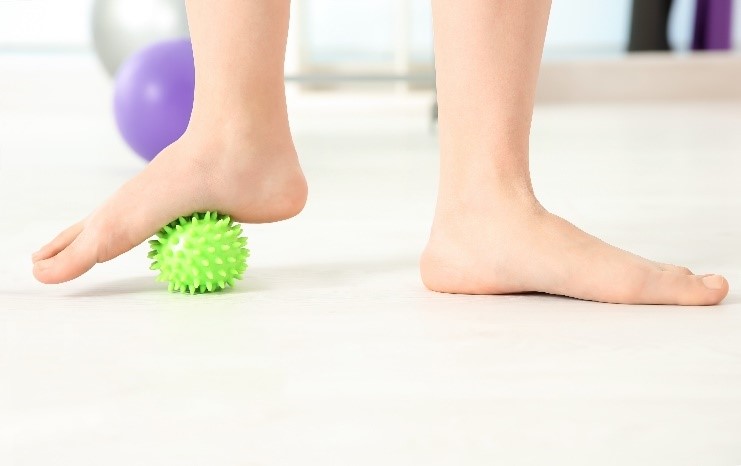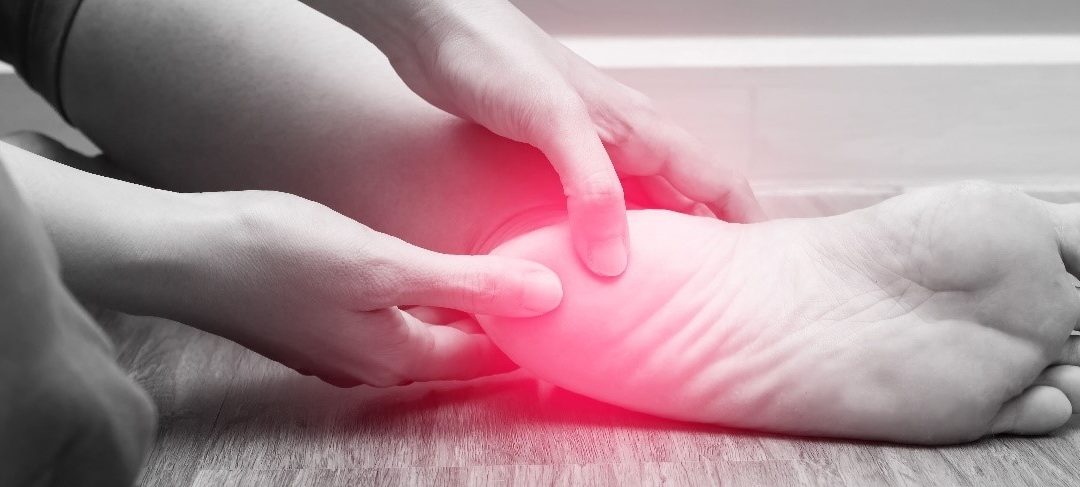Plantar fasciitis (pronounced PLAN-TUR-FASH-E-ITIS) is the commonest cause of pain in the heel. Heel pain affects celebrities, athletes, ballet dancers, and in fact 1 in 10 of us at some point in our lives. In this article we look at 10 top tips to curing plantar fasciitis.
What Causes Plantar fasciitis?
The plantar fascia is a thick band of tissue that runs from your heels to your toes. It acts like a bowstring which is responsible for the spring in your step. Plantar fasciitis is inflammation of the plantar fascia. Which results from microtears caused either by an acute injury or repetitive overuse.
Initially, this causes an acute inflammation which over time becomes chronic. This causes the plantar fascia to become thickened and swollen. New nerve pain fibres sprout into the inflamed tissue which hurts every step you take. I often tell my patients that it is like a tennis elbow of the foot. Whilst you can rest your arm easily in tennis elbow, you cannot really rest your foot.
What are the symptoms of plantar fasciitis?

Plantar fasciitis causes a stabbing pain that is mostly felt when you first step out of bed in the morning. As you get up and walk around the pain may settle a little. But then after lots of activity may return especially after hours of standing. Which is where the term Policeman’s heel came from. The pain from plantar fasciitis is often worse after exercise rather than during it, and it can affect one or both of your feet.
What about my heel spurs?
Plantar fasciitis is often mistakenly called heel spurs. The issue of heel spurs causes huge confusion, especially if they have been noted on an X-ray and cause a lot of unnecessary worry. In fact an article in the New York Times famously accused Donald Trump of avoiding the draft to Vietnam because of heel spurs.
It is true that a lot of people with plantar fasciitis have heel spurs but the bone spurs themselves are not the cause of plantar fasciitis pain. We know that because 1 in ten (10%) healthy people have heel spurs. But only 1 out of twenty (5%) of those with heel spurs have plantar fasciitis. It’s probable, although unproven, that the heel spur forms because of repeated traction or pulling on the heel bone by the muscles in the foot just above the attachment of the plantar fascia. The most important point is that plantar fasciitis can be treated without taking off the heel spur.
What are the risk factors for plantar fasciitis?
Plantar fasciitis is most common during the ages of 40-60. It is often triggered by a change in walking or running habits. So if you have increased your levels of activity, changed from running on grass to running on hard surfaces, or changed your shoe wear then you are at higher risk of developing plantar fasciitis.
Because about ten times your body weight can go through your foot when you jump, hop or skip. Then being overweight clearly increases the stresses on your feet and can make plantar fasciitis much worse. Also, your foot shape may be a factor. In people with flat feet the plantar fascia is often stretched and in people with high arches the plantar fascia is often tight.
Another really important factor is tight heel cord or tight calf muscles (known as gastrocnemius) as when these are tight there is less give in movement and higher forces are transferred to the foot during running or walking.
How is plantar fasciitis diagnosed?
The diagnosis is usually a clinical one but a specialist opinion is helpful to rule out other potentially more serious conditions like stress fractures, arthritis or pinched nerves. Your specialist may suggest an investigation like ultrasound scans, or MRI scans to rule out these other conditions. Also its important to rule out a tear of the plantar fascia which may suggest a period of rest is needed. If your pain is severe, and you have had a history of a sudden injury then ruling out a tear is important.
What happens if I ignore my plantar fasciitis?
If you ignore the symptoms of plantar fasciitis (often mis-spelt planters fasciitis, plantar fashitis or planter tendon) then you may compromise the way you walk or exercise. So aside from the progressively worsening foot symptoms, you may also start to develop pains that involve other parts of your body like knee, hip or back pain, and so its important to seek plantar fasciitis relief although my experience is that patients in the main want a plantar fasciitis cure.
What is the treatment for plantar fasciitis?
Most people who have plantar fasciitis heel pain recover fully but it can sometimes take months and self-help plantar fasciitis treatments are really important. I think its important that you calibrate your expectations at the outset, as there is no miracle cure for plantar fasciitis and even if you work at it, it could be months before things improve. Below are my plantar fasciitis treatment recommendations, many of which you can do straight away, others will require the help of a specialist:
Pain killers
Paracetamol (acetaminophen) which includes brand names such as Panadol, Tylenol or Actamin can be useful. As well as anti-inflammatory drugs such as ibuprofen, which includes brand names such as Nurofen, Advil or Motrin. Taking paracetamol and ibuprofen together is a useful combination for plantar fasciitis pain relief. You must of course always speak to your healthcare professional before taking any medication to check they are safe for you. There are some topical pain-killing medications like anti-inflammatory creams that can be purchased over the counter and providing you follow their instructions they can be useful as well.
Ice
Icing the area using a cold compress or rolling your foot over a frozen bottle of water for 10 minutes can help settle the pain. Remember to pour out a quarter of the plastic bottle of water before you put it into the freezer or it may explode. Always wear a sock or place a thin towel over the ice to avoid an ice burn.

Spikey Ball
A spikey ball (can be spelt spiky ball) should become your best friend. I recommend purchasing an 8cm firm (but not hard) spikey ball, about the size of a tennis ball. I tell patients to place this onto their mobile phone when they go to bed at night. Why onto their mobile phone? Well because its usually the first place they go in the morning, and I want you to pick up the spikey ball before you get out of bed.
This is a really important point. You must not stand up but instead as soon as you wake up, swivel round and place the ball on the floor under your affected heel and roll the ball under your heel and from your toes to your heel, for 1-2 minutes to get a stretch of the plantar fascia. Then stand onto the ball and roll it under your body weight for 1-2 minutes before getting on with your day. Do the same after getting up from a chair and before going to bed at night.
Some people recommend a rolling pin or a tennis ball as a replacement for a spikey ball and there is nothing wrong with these but personally I don’t find they are as good at treating plantar fasciitis because they don’t provide as much deep tissue massage. Nor are they as good at stimulating the nerve fibres in your feet. Birkenstock shoes use the same pointed prongs and a lot of patients really like this.
Weight loss
Losing excess weight can really help reduce the stresses on the plantar fascia. I often have to help patients that say they cannot exercise because of the pain. In these situations we used off loading exercises that get the heart working such as cycling, walking in water exercise (hydrotherapy) and Pilates based mat-work.
Physiotherapy
Also known as physical therapy is extremely important to treat plantar fasciitis. Exercises to stretch any tight heel cords (which must be with a straight knee), as well as work on your core-stability, and assessment of your walking and running patterns are really essential in the treatment of plantar fasciitis to get you back to walking and running pain-free.
Night Splints
Another way to stretch a tight heel cord is to wear a splint at night time. “Why would I want to wear a night splint?” I hear you ask. Well the reason is because at night time we sleep with our toes pointed out and so the calf muscles are relaxed. A night splint keeps a gentle stretch on them as you sleep. Which can help relieve plantar fasciitis but must not be used as a substitute for physical therapy and proper stretching exercises.
A lot of patients find night splints uncomfortable so these are not my first choice of treatment. Some patients have tried plantar fasciitis socks which have a clip to the front of the shin to pull the toes up. Although I do not have much feedback as to whether they are useful.
Silicone heel cups
Some patients find wearing of silicone heel cups helpful. Aside from the shock absorbing role they play, they do of course also take some strain off from the Achilles tendon and tight calf muscles. So again these can be used but are not a substitute for calf stretching exercises.
Orthotics, Shoe inserts and Shoes
Orthotics for plantar fasciitis is one of the commonest questions I am asked about. off-the-shelf or custom orthotics, insoles or inserts can be useful to provide support for the foot arches. You can buy over the counter orthotics for plantar fasciitis from Amazon. I always recommend full length inserts and never half or two thirds length because its important to replace the insole inside your shoes and not add to them, as for most of us our feet don’t fit well into our shoes and there is no logic in trying to stuff an additional insole into your shoes. Just as important as the insert is a good pair of supportive shoes with good shock absorption such as Kybun shoes (see figure below).

Shock wave therapy
Extracorporeal shock wave therapy fires high-frequency sound waves into the tissues to encourage healing. It is usually reserved for failure of all the other treatments where the condition is becoming chronic. It usually involves three treatments each given a week apart.
Steroid Injections
Injections of steroids into the plantar fascia are sometimes used but must be tried with extreme caution and only used by an expert. Because a steroid injection which accidentally injected into the heel fat pad can cause atrophy of the fat pad and intractable pain. Which is almost impossible to treat. Steroids can also weaken the tissues and increase the risk of tears. I find injections useful for patients that have a lot of bone marrow oedema on their MRI scans which is a form of bone bruising to settle down the inflammation.
Surgery
This is rarely needed to treat plantar fasciitis but can be helpful in refractory cases which aren’t responding to other treatments. Surgery may involve releasing overtight calf muscles or even releasing the plantar fascia from the bone using a minimally invasive technique. You are always advised to seek a second opinion before undergoing surgery for plantar fasciitis.
What about nutritional supplements for plantar fasciitis?
As with any musculoskeletal problems its important to have a healthy and balanced diet. I am often asked if there are any nutrition and supplements that can help with plantar fasciitis. Having studied the literature I can tell you that the evidence to support the use of supplements is weak. Certain nutrients have been proposed to help build strong tendons and ligaments by being building blocks for proteins and the immune system. These include magnesium, Zinc, Vitamin C, Vitamin B5 (pantothenic acid), and fish oils with omega-3 fatty acids. Whilst the evidence to support their use is lacking, I do hear a lot of positive feedback from some of my patients and so I have no problem in them taking these supplements as long as they are on top of and not in replacement for a healthy diet.
Questions to ask your doctor if you suffer from plantar fasciitis.
- What is causing my symptoms?
- Do I need any special tests?
- How long will it take for this to get better?
- What’s the best treatment plan for me?
- Are there any alternatives to what you are suggesting?
- Is there anything I need to avoid?
- Do you recommend any patient information guides or websites for more information?
Did you enjoy this article? You may also like What can i do for an ankle sprain?

